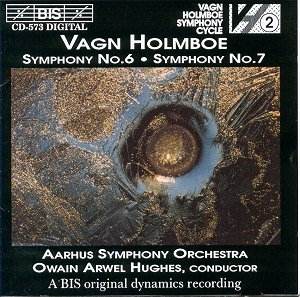|
|
Search MusicWeb Here |
|
 |
||
|
Founder:
Len Mullenger (1942-2025) Editor
in Chief:John Quinn
|
|
|
Search MusicWeb Here |
|
 |
||
|
Founder:
Len Mullenger (1942-2025) Editor
in Chief:John Quinn
|
 |
Vagn HOLMBOE (1909-1996)
Symphony No 6 Op 43 (1947) Symphony No 7 in one movement Op 50 (1950) Owain Arwel Hughes Recorded June 1992 Musikhuset, Aarhus |
| CD available for post-free online mail-order or you may download individual tracks. For some labels you can download the entire CD with a single click and make HUGE savings. The price you see is the price you pay! The full booklet notes are available on-line. |  |
|
NOTE • Click on the button and you can buy the disc or read the booklet details • You can also access each track which you may then sample or down load. • Further Information. |
|
|
Holmboe followed the success of his wartime Fifth with the 1947 Sixth. Unlike his earlier cataclysmic work, violent, unremitting, its benevolence won at hard cost, the Sixth opens gently with an adagio of evolutionary function and great perception. There is a slow rocking to and fro, descending motifs, especially from the woodwind, the intervallic tension becoming more and more explicit as the horns announce their presence and the strings seem to darken from their initial translucence. At 5.05 there is a skittish, chatty woodwind section, folkish with off beat pizzicatos and this announces the allegro section of the movement. This grows brasher and friskier by the bar, orchestral colour prominent and much rhythmic incision, which leads to a strongly forward-looking brass led passage. The concluding adagio section is flecked by romantic clarinet and high violin writing over the pizzicato underpinning – the reminiscence of the initial idea in the movement closes it was decisive direction. By contrast the second movement of this two-movement symphony opens in dramatic, fractious and truculent fashion, as if the first movement were more illusory, more phantom in its import. Swirling strings and rhythmic disjunctions are reminiscent of Shostakovich and the manner in which a lone trumpet figure is picked up by the strings, mused over and transformed as it snakes its way throughout the orchestra is a dramatically effective piece of mutative development, practised with by now accustomed mastery by Holmboe. From 5.10 there is an inexorable tread palpable in the music occasionally slaked by uneasy twists and moments of cautious repose before four big implacable chords end the work in something like peremptory decisiveness.
The Seventh Symphony dates from 1950 and is a one movement structure of some formal complexity – with three main sections alternating with little intermezzo sections, noted by Holmboe as Intermedio I – III. Opening in vigorous, martial fashion it relaxes briefly to investigate some woodwind motifs, with some Mahlerian sounding material audible in the undergrowth of the bass’ passages. The Intermedio acts as a short, seamless bridge passage, the first being chorale like, and leading onto an adagio section. There are short motifs here for lower strings and a keening clarinet and a general air of directionless and unease at a walking tempo underpinned by Holmboe’s animating bass pizzicati. There is a gradual but definable gathering up of tensile strength supported first by the trumpet and then by a fairly brittle string attack. The second Intermedio explores the sonority produced between registral extremes whilst the Presto brings an animated flute and a sense of flourishing colour before bursting out in raucous and strident freedom. The final Intermedio brings immediate lightness and cleansing leading on to the mysterious coda – which begins with a rising, questioning motif from the woodwind and omnipresent bass undertow. The strings are similarly affected and rock to and fro, as in the opening of the Sixth, leaving one with the inescapable conclusion of something left unsaid, as if the symphony has further yet to go; when it does so it brings an end but not a release. Somewhere, we uneasily feel, beyond the confines of the manuscript paper the symphony is still being endlessly and permutativeley played out.
BIS’s production values are superlatively high in this series and the same is true of orchestra and conductor.
Jonathan Woolf
|
Symphony
no.7 in one movement op.50 Get a free QuickTime download here |
|
ADDITIONAL INFORMATION •
You can sample only 30 seconds (or 15% if that is longer) of a given track. Select from the View tracks list. Each sample will normally start from the beginning but you can drag the slider to any position before pressing play. • PLEASE NOTE: If you are behind a firewall and the sound is prematurely terminated you may need to register Ludwig as a trusted source with your firewall software.
•You will need Quicktime to hear sound samples. Get a free Quicktime download here • If you cannot see the "Sample All Tracks" button you need to download Flash from here.
|
|
|
Return to Index |